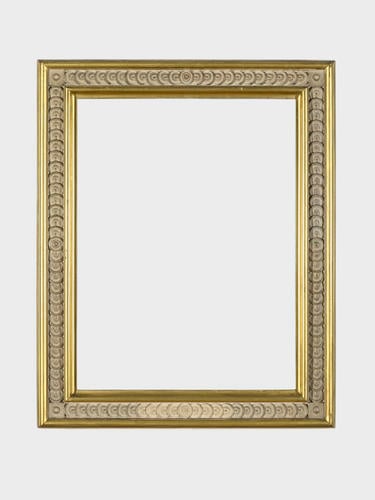-
1 of 253523 objects
Frame for RCIN 402736, 17th century, Portrait of a Woman 19th Century
Gilded and painted | 71.7 x 57.8 x 5.0 cm (frame, external) | RCIN 7402736

Master of the Holbein Room picture frame
Frame for RCIN 402736, 17th century, Portrait of a Woman 19th Century
-
This frame style, with a design of repeating discs or coins in the frieze, is associated with paintings displayed from c. 1850-1992 in a small room or passageway situated to the south-east corner of St George’s Hall at Windsor Castle. The room occupied the site of the current private Chapel, adjacent to the Lantern Lobby, built following the fire of 1992. It was here in the mid-19th century that Prince Albert organised a dense display of portraits of early British and Continental Kings and Queens, and to give coherence and homogeneity to the scheme new frames were commissioned.
The room, known by the early 20th century as the Holbein Room, was recorded in a photograph commissioned by Queen Mary from Edward Hudson of Country Life in 1931 (see RCIN 2100997 or 2407806). It linked the private apartments of the monarch with the State Apartments at first floor level; the awkward shape dictated by the adjacent Private Chapel (previously a Music or Band Room) created for Queen Victoria in c. 1840.
The display incorporated some of the earliest paintings in the Royal Collection, including at least twelve documented at Whitehall in Henry VIII’s 1542 inventory. During the reign of Charles I many of the portraits were recorded in the Privy Gallery at Whitehall. Some formed the set of '31 pictures of King's and Princes' sold in 1650, a number of which were recovered at the Restoration and returned to the Privy Gallery by 1666. By the 1730s they were to be relocated to Kensington Palace for German-born Queen Caroline (1683-1737) in displays that reflected her lively interests in the arts, genealogy, and history.
Although the production and collecting of standard portrait types was stimulated by the creation in the 16th century of Long or Great galleries in country or royal houses, by the mid-Victorian era this concentrated gathering of royal portraits perhaps betrays unusual antiquarian interest. It undoubtedly reflects Prince Albert’s deep interests in history and desire to order the royal collection, bringing coherence through the use of uniform frames.
The design is inspired by early 16th century Italian cassetta frames, which consist of straight outer edges encasing a frieze defined by distinct mouldings – for example, a double guilloche pattern in the case of the early 16th century Venetian frame on Raphael’s Madonna of the Pinks in the National Gallery, London (NG 6596).
The motif of repeating discs or coins on a ribbon references older architectural borders of classical doors and windows. It is also a motif that appears in 19th century door frames in both Windsor Castle and Buckingham Palace. The frieze has a stylised flower-head or patera at each corner.
The frieze ornament is made of composition (chalk-based material) which is then pressed into a mould –so these frames are constructed in a similar manner to their 16th century cassetta predecessors which would have been press-moulded ‘pastiglia’ (normally based on gypsum and glue).
The smaller portraits from the display, which included European monarchs, hung on the lower tier and required a dark painted slip to offer homogeneity to the display. Some of these were inscribed in gilt with the name of the sitter (for example, the frame for painting thought at one time to depict the humanist scholar and physician Thomas Linacre, RCIN 7402721); the calligraphy is thought to be contemporary with the framing - the intention probably being to echo the gilt inscriptions in Latin identifying the sitters on some of paintings.
At the lower centre of each frame is a giltwood tablet, thought to date from the early 20th century, bearing the sitter’s name and occasionally the artist, although some have now been removed.
The late twentieth and early twenty-first century has heralded new thinking and approaches to framing, as well as the creation of refreshed picture displays in royal residencies. As a result, some of the paintings were reframed in 20th century reproductions of British 16th century black-stained and parcel gilt cassetta-style frames, or surrounds that mimic early integral frames, which are closer to how the paintings would originally have been framed (for example, the frame for Edward IV, RCIN 7403435 and the frame for Arthur, Prince of Wales, RCIN 7403444). -
Creator(s)
-
Medium and techniques
Gilded and painted
Measurements
71.7 x 57.8 x 5.0 cm (frame, external)
59.3 x 45.5 cm (frame, rebate)
55.7 x 41.9 cm (sight)
Category
Object type(s)